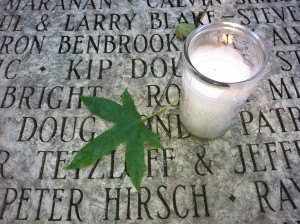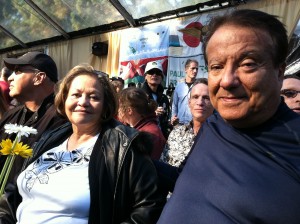
San Francisco’s Golden Gate Park is one of the city’s top tourist attractions. And yet very few of the thousands who visit the park each year ever stop to see the National AIDS Memorial Grove, just a stone’s throw from the popular de Young Museum.
And until last night, I was one of them.
I attended a candlelight event, and returned today for World AIDS Day.
Nestled beneath a gorgeous stand of trees, the Grove is a living memorial to those who died from HIV/AIDS and others who cared for them. In its designation as a national memorial, it’s comparable to the Vietnam Wall in Washington or the U.S.S. Arizona at Pearl Harbor. But unlike those memorials remembering past wars, this one continues adding names of those lost to this epidemic. A new documentary, “The Grove,” tells the memorial’s story, including a controversy over how best to artistically depict it. “The Grove” airs this month at different times on KQED TV and on PBS stations across the nation.
At today’s event I met the parents of the person whose name was most recently added. Yolanda and Richard Jordan traveled from El Paso, Texas to see the memorial and the unveiling of their son Richard’s name. He died of HIV/AIDS in February at the age of 41. As tears streamed down their faces, the Jordans said how proud they were of their late son and what he had accomplished in his too-short life.

Like anyone who was here 30 years ago, I remember vividly those first news reports of a mysterious illness striking young gay men. In the days before a cause was determined, much less any treatment, I was among the “worried well” — filled with anxiety that we might be the next “victims” of the disease then called GRID (Gay Related Immune Deficiency).
